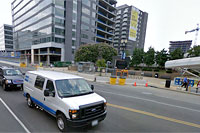Remove rush hour parking? Or allow parking all the time?
Many streets in DC have signs that prohibit parking during rush hour. They ensure that the widest possible street is available for cars, buses, or bikes to travel during the busiest, most traffic-heavy times.
But is the widest possible street really the best street? Is an open travel lane really the best use of space everywhere those signs are placed?
I work on M Street SE, near the ballpark. During rush hour, parking is restricted on both sides, and vehicles get a full six travel lanes. On many parts of the street, the sidewalks are narrow and the crosswalks are not signalized. Since the street is wide and traffic is light, cars travel well over the 25 mph speed limit on this road, making the area uncomfortable and unsafe for cyclists and pedestrians.
While Canal Park is being constructed, DDOT is conducting an unintended experiment along the M Street corridor. One block of M Street has been narrowed from three lanes to two, and one lane is used by pedestrians behind a temporary barrier. I have not noticed an increase in congestion due to this narrowing, suggesting that three lanes are not necessary to carry the traffic flow.
By allowing cars to park alongside one or both sides of a street during rush hour, that effectively narrows the street by one lane permanently. Not only does this provide more space for parking, which could help local businesses, it also allows DDOT to design the street with bus bulb-outs, intersection extensions, or other changes in the balance of space between that devoted to cars and other users like pedestrians.
Eliminating rush hour parking restrictions would also simplify parking signs, improving the legibility of signs so that drivers are less confused about whether they can park. Allowing parking would provide the District with more revenue from parking meters.
On the flip side, some streets are congested long after the official sign-mandated rush hour periods are over. For those streets, DDOT should consider eliminating street parking altogether, and devoting the space to dedicated cycle tracks, bus lanes, or other non-automobile uses.
Sure, some streets have so much traffic that eliminating a whole travel lane is not possible at this time. But there are many streets that have rush hour parking and virtually no traffic, and DDOT should start assessing which restricted streets could be opened up for parking and which could have parking eliminated.
A good place to start would be M Street SE. They’ve already done it with one block. Why not the rest?

